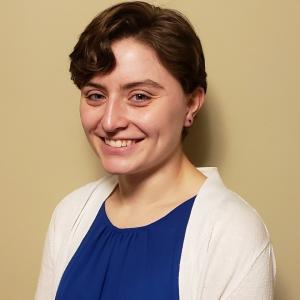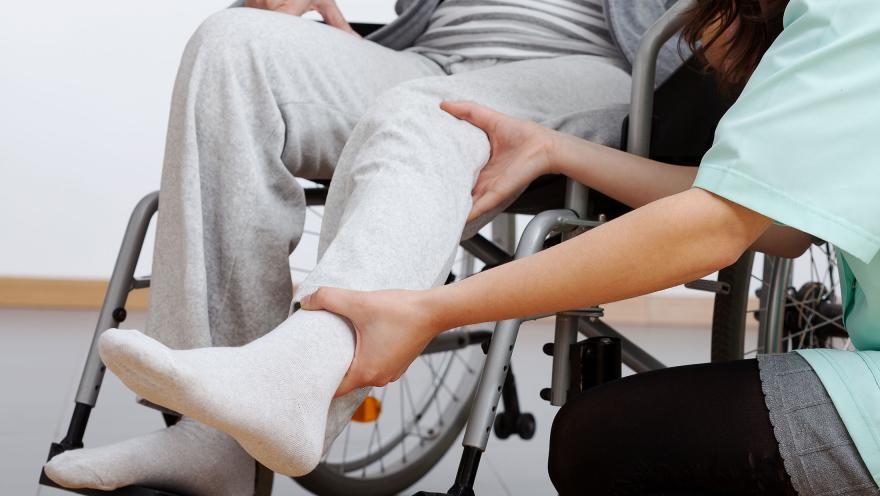In recognition of National Physical Therapy Month, we checked in on ways this critical piece of multidisciplinary care helps people living with ALS and innovative ways telehealth can be incorporated into the practice. Like many aspects of life, the COVID-19 pandemic has transformed the delivery of physical therapy in 2020 – short term changes that could have long-term ramifications for the practice.
Physical therapists are key members of the mobility team for a person living with ALS. As ALS progresses, most people gradually lose their ability to use their arms and legs as their muscles weaken. Physical therapists help patients maintain as much independent function as they are capable of at different points throughout the disease to improve their quality of life.
We spoke with Renée Hetzler, physical therapist at the University of Rochester Medical Center’s multidisciplinary ALS and Huntington Disease Clinics, who shared her thoughts and experiences with patients and insights about the importance of physical therapy for people living with ALS.

How long have you been a physical therapist and what made you choose the practice as a career?
I have been a physical therapist for 4 years. I have wanted to pursue physical therapy since middle school because I was interested in the human body and function, and I wanted a career that was devoted to helping people. During college I became especially interested in working with people with neurologic conditions because they can be so varied and interesting.
Can you explain what physical therapy is as a practice?
Physical therapy as a practice helps people improve their mobility and function by determining what limitations need to be addressed and how best to address them. Physical therapists are movement experts. We guide people towards their goals of being able to do any activity that is important to them by using exercise prescription, education, and equipment recommendations.
Physical therapists are an important part of multidisciplinary care for people living with ALS. Can you explain the benefits of physical therapy for people living with the disease?
Many people do not understand why physical therapy can help people with ALS because it is a progressive disease. While physical therapy cannot halt the inevitable loss of muscle strength, we can support people with ALS and help them maintain whatever independent function they are capable of at different points throughout the disease. We often prescribe equipment such as braces or walking devices early on in the disease that help people maintain the ability to walk longer. As weakness progresses, we recommend a variety of other equipment to help with transfers, being able to get in and out of bed, being able to use the bathroom safely, and getting in and out of cars. We discuss any home modifications that may be necessary as the disease progresses, keeping in mind that it is best to plan ahead with a rapidly progressing disease. When people lose the ability to walk, we help them get custom wheelchairs that will help them be comfortable and still be able to get around on their own. We also prescribe exercises such as moderate strengthening to maintain function and stretching to help reduce joint stiffness and pain. As a person becomes more reliant on caregivers, we help educate caregivers on the best techniques to help them take over the responsibilities of stretching, transfers, and performing basic daily tasks safely. Our ultimate goal for people with ALS is to help them maintain function and quality of life as the disease progresses.
Although no two cases are alike, what does a typical appointment look like with a person living with ALS? What are you typically assessing and/or looking at and how do you provide assistance?
My primary interactions with people with ALS are through our multidisciplinary clinic at the University of Rochester Medical Center. I occasionally follow up with patients on an outpatient basis, but for the most part I consult with them every few months when they attend our multidisciplinary clinic. In a typical appointment, I try to assess what areas of the body have the most notable weakness and how that is affecting their function. If someone has more weakness in their legs, I will discuss strategies, equipment, or exercise recommendations that will help them be able to get up from a chair more easily or walk safely. If they have more weakness in their arms and hands, I will discuss strategies they can use to perform things like dressing or carrying things safely. I will also often refer people with upper extremity weakness to occupational therapists as they are immensely helpful in recommending adaptive equipment to perform activities that are impacted by hand weakness. In addition to assessing strength, I also note which body parts are starting to get tight and I prescribe stretching to address this. I educate people about the benefits of continuing to exercise as able. I also spend a lot of time educating about different equipment recommendations and trying to problem-solve specific issues that people are reporting, such as how they can open up their refrigerator by themselves when they are unable to grab the handle.
How has the COVID-19 pandemic affected your everyday practice treating people living with ALS?
COVID-19 has shifted more of my interactions to virtual visits. Our multidisciplinary clinic has switched to a hybrid of in-person and virtual visits. At the beginning of the pandemic, this interrupted our care while we sorted through the logistics and new technology. However, we are now able to see patients with each discipline in person or virtually based on patients’ needs and wishes. Some people like the option of virtual visits so they do not have to travel far to attend in-person.
Are you able to help people living with ALS via telehealth? And if so, what does that look like?
I am able to work with patients primarily on a consulting basis via telehealth. During our clinic, each discipline is able to log onto a video visit along with the patient and family members so we can see and hear each other. This virtual interaction has made it somewhat more challenging to fully assess someone’s limitations, but if the set-up is good I am still able to get a good sense of their functional mobility by asking them to stand up from a chair or walk across the room. A lot of my education to patients is driven by their questions, so that has largely remained the same. I am not able to show patients equipment or have them try it via a virtual appointment, but I can show them what something looks likes and tell them where they can find the equipment near them. Telehealth has also allowed me a much clearer picture of people’s home environment which helps me make appropriate recommendations for equipment or modifications.
In your opinion, do you think this virus will change the future of telehealth in this country? If so, how?
I am hopeful that in the future telehealth will be an integrated option for medical care, for certain circumstances. For many types of problems, it is certainly best to be seen in person, but for more simple issues I think telehealth reduces the burden of seeking care for individuals. This is especially true for diagnoses like ALS where specialized providers are not commonly available, so patients and families may have to travel hours to seek care. If telehealth can reduce this burden, I think it would be a good way for people to access care.
What do you like to do when you are not working?
I enjoy playing basketball and I officiate high school basketball during the winter. I also enjoy hiking, running, and biking. I like to watch a lot of movies and I am a big Harry Potter fan. I also enjoy reading and doing various volunteer work.
Dr. Hetzler is an outpatient physical therapist at the University of Rochester Medical Center, treating a variety of neurologic disorders. She serves as the physical therapist at the University’s multidisciplinary ALS and Huntington Disease Clinics. Renée received her Board Certification as a Neurologic Clinical Specialist after completing a neurologic physical therapy residency program at the Boston VA Healthcare System, during which time she served in the multidisciplinary ALS clinic. Renée has a special interest in exercise prescription and equipment recommendations, including bracing and wheelchair needs, for people with neurologic conditions.


Comments
Question: How do I know if the arom ex Im giving for a home ex program is too hard causing prolonged muscle soreness and fatigue? What is a reasonable amount of time to recoup from a long walk (Amb distance 300ft)? How long should "tired" be a concern? What signs should I look out for when progressing BLE ex?
Connie, we recommend going to your doctor with any questions and concerns, as we cannot provide medical advice. The ALS Association is a patient advocate organization that funds research, provides general information (non-medical), offers resources and support, and advocates for legislation.
Join the conversation. Please comment below.